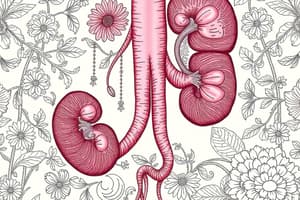Podcast
Questions and Answers
What is the most common cause of kidney stones?
What is the most common cause of kidney stones?
- Changes in urine pH
- High intake of calcium
- Urinary tract infection
- Supersaturation of the urine with precipitation of stone-forming substances (correct)
What is the most common type of kidney stone?
What is the most common type of kidney stone?
- Calcium oxalate (correct)
- Cystine
- Uric acid
- Magnesium ammonium phosphate
What is the consequence of upper motor neuron lesions above the pontine micturition center?
What is the consequence of upper motor neuron lesions above the pontine micturition center?
- Increased bladder capacity
- Detrusor hyperreflexia and uninhibited bladder (correct)
- Detrusor hyporeflexia and inhibited bladder
- Decreased bladder sensation
What can result in progression to chronic kidney disease in untreated obstructive uropathy?
What can result in progression to chronic kidney disease in untreated obstructive uropathy?
What are the most serious complications of urinary tract obstruction?
What are the most serious complications of urinary tract obstruction?
What causes obstructions of the bladder?
What causes obstructions of the bladder?
What is the cause of a neurogenic bladder?
What is the cause of a neurogenic bladder?
What is the result of upper motor neuron lesions between C2 and S1?
What is the result of upper motor neuron lesions between C2 and S1?
What is the result of lower motor neuron lesions below S1?
What is the result of lower motor neuron lesions below S1?
What is OAB syndrome characterized by?
What is OAB syndrome characterized by?
What are the common anatomic obstructions to urine flow?
What are the common anatomic obstructions to urine flow?
What can result from partial obstruction of the bladder?
What can result from partial obstruction of the bladder?
What are bladder tumors commonly composed of?
What are bladder tumors commonly composed of?
What tends to happen to larger neoplasms of the kidneys over time?
What tends to happen to larger neoplasms of the kidneys over time?
Flashcards
Common cause of kidney stones?
Common cause of kidney stones?
Supersaturation of urine with stone-forming substances.
Most common kidney stone type?
Most common kidney stone type?
Calcium oxalate.
Upper motor neuron lesion consequence?
Upper motor neuron lesion consequence?
Detrusor hyperreflexia and uninhibited bladder.
Untreated obstructive uropathy result?
Untreated obstructive uropathy result?
Signup and view all the flashcards
Serious urinary tract obstruction complications?
Serious urinary tract obstruction complications?
Signup and view all the flashcards
What causes bladder obstruction?
What causes bladder obstruction?
Signup and view all the flashcards
Cause of neurogenic bladder?
Cause of neurogenic bladder?
Signup and view all the flashcards
Upper motor neuron lesion result (C2-S1)?
Upper motor neuron lesion result (C2-S1)?
Signup and view all the flashcards
Lower motor neuron lesions (<S1) result?
Lower motor neuron lesions (<S1) result?
Signup and view all the flashcards
OAB syndrome characterized by?
OAB syndrome characterized by?
Signup and view all the flashcards
Common anatomic urine flow obstructions?
Common anatomic urine flow obstructions?
Signup and view all the flashcards
Partial bladder obstruction result?
Partial bladder obstruction result?
Signup and view all the flashcards
Bladder tumors composed of?
Bladder tumors composed of?
Signup and view all the flashcards
Larger kidney neoplasms tend to?
Larger kidney neoplasms tend to?
Signup and view all the flashcards
Study Notes
Kidney Stones
- The most common cause of kidney stones is dehydration.
- The most common type of kidney stone is calcium oxalate.
Neurological Effects on Micturition
- Upper motor neuron lesions above the pontine micturition center result in urinary retention.
- Upper motor neuron lesions between C2 and S1 result in spastic bladder.
- Lower motor neuron lesions below S1 result in flaccid bladder.
Urinary Tract Obstruction
- Untreated obstructive uropathy can result in progression to chronic kidney disease.
- The most serious complications of urinary tract obstruction include chronic kidney disease, hypertension, and infection.
- Obstructions of the bladder can be caused by prostate enlargement, bladder tumors, urethral strictures, and neurogenic bladder.
Bladder Disorders
- A neurogenic bladder is caused by neurological disorders such as spinal cord injury, multiple sclerosis, and Parkinson's disease.
- Overactive bladder (OAB) syndrome is characterized by urinary frequency, urgency, and incontinence.
Anatomic Obstructions
- Common anatomic obstructions to urine flow include prostate enlargement, bladder tumors, urethral strictures, and ureteropelvic junction obstruction.
- Partial obstruction of the bladder can result in bladder wall thickening and hypertrophy.
Bladder Tumors
- Bladder tumors are commonly composed of transitional cell carcinoma.
- Larger neoplasms of the kidneys tend to invade nearby tissues and metastasize over time.
Studying That Suits You
Use AI to generate personalized quizzes and flashcards to suit your learning preferences.




